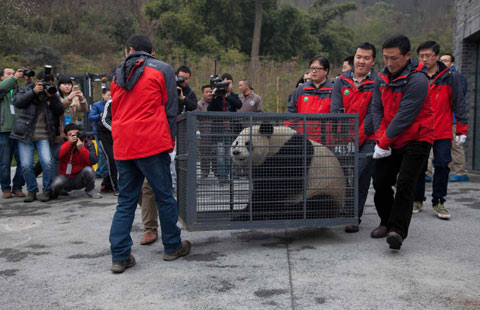Lhasa orphans mark Tibetan New Year with noodle feast
Updated: 2014-03-03 08:24
By Palden Nyima and Daqiong in Lhasa (China Daily)
|
||||||||
|
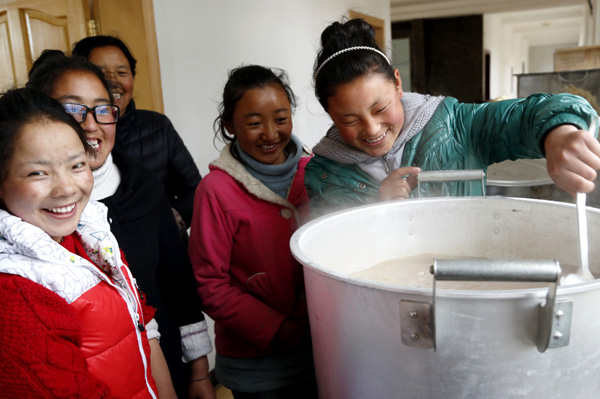 A girl cooks guthuk at the Gyalzur Tendol Orphanage in Doilungdeqen county, Lhasa, the Tibet autonomous region, on Friday.[Photo by Palden Nyima/China Daily] |
Auspicious greetings, barley wine, prayer flags, fireworks, and laughter filled the air in Lhasa on Sunday as Tibetans dressed in their best clothes to embrace the Tibetan New Year, known locally as Losar.
According to the Tibetan calendar, this year is the year of the Male Wooden Horse, and it started on Friday, which was the 29th day of the 12th month on the Tibetan calendar.
While the noodles and the broth in which they are served are delicious enough, there is an added treat included in the meal. Enfolded into a few of the guthuk dough-balls are materials with a symbolic meaning, either good or bad.
Carefully cutting the balls open, diners may find a small ball of wool or a scrap of paper, which symbolizes some aspect of their character of their way of life. The balls are distributed randomly, making the process all the more mysterious.
The children of Gyalzur Tendol Orphanage in Lhasa's Doilungdeqen county were particularly excited by the festive occasion, especially the guthuk feast and its associated game of symbols.
Most of the 61 children who have made the orphanage the home were present for the occasion, returning from their temporary lodgings at schools or colleges.
"I got wool in my bowl of guthuk, which means I am a good-tempered person," said Tseyang, a Tibetan girl who still thinks of the orphanage as home, despite having moved away to study at the Tibet Medical College.
Among those helping to make the meal is Tsamjo, one of the two nurses at the orphanage. She has been working there for 21 years.
"Traditionally, guthuk contains nine ingredients, such as yak meat, cheese, a wild sweet potato called toma, cabbage, wheat, barley, beans, water, and salt," she said.
"Anything you find in your guthuk has a symbolic meaning. For example, paper in one's dough-ball suggests that one likes wandering here and there, and cheese represents a pure heart," she said.
"A broken piece of the bowl itself means one is gluttonous and lazy; a sun and moon in the bowl means good luck; and charcoal means something bad."
The children follow the feast with additional activities to bring on good luck and wash away the bad. They dispel evil spirits with the guthuk ritual, involving the anointment of their bodies with a paste made from roasted barely flour. Then they set off fireworks as a final signal that the New Year has really begun.
The festivities continued on Sunday morning, with the two nurses, Tsamjo and Tashi Lhamo, rising early to cook changku - cheese, brown sugar and roasted barley flour boiled in barley wine.
The children all got up at the crack of dawn and tucked into their changku breakfast, boosted by plates of khapsay - fried, sweet pastries.
Next, they made good-luck offerings to each other made from chemar - a mixture of roast barley flour and butter.
The various ceremonies represent both hopes for the future and thanks for the kindness of others.
An act of kindness
The orphanage was founded in 1993 by Gyalzur Tendol, a Tibetan woman who had moved to Europe and trained as a medical assistant. Over the past two decades, the orphanage has provided a home in Lhasa to 108 orphans and children with only one parent. Some of the children have gone on to study medicine, reflecting the altruistic aspirations of the founder.
"I was fostered when I was only 5 years old, and I stayed in the orphanage until I was 18. I feel very pleased to be back for Losar celebrations," said Chimed Droma, 24.
"Best wishes to all our donors, Mrs Tsamjo and the nun Tashi Lhamo, and all our brothers and sisters in this big family - and may you all be happy and healthy in 2014," she said.
As the warm sunshine poured into the orphanage yard, the children gathered there for traditional circle dances, just one of many outdoor activities that Tibetans traditionally enjoy at this festive time.
"The Tibetan New Year festival traditionally lasts for 15 days, but nowadays it varies from three to seven days, and sometimes 15," Tsamjo said.
On the first day of Losar, most Tibetans in the Lhasa area make a pilgrimage to the Buddhist temples of Jokhang and Ramoche and to the Potala Palace.
In the coming two weeks, Tibetans will enjoy parties, exchange gifts and greetings, hold special Buddhist prayer sessions and racehorses on the grassy plains.
Tibetan historical records show that the tradition of Losar dates back to about 100 BC, the time of the ninth king of Tibet, Pude Gungyal.
Contact the writers at palden_nyima@chinadaily.com.cn and daqiong@chinadaily.com.cn

 Rio drops protests for Carnival
Rio drops protests for Carnival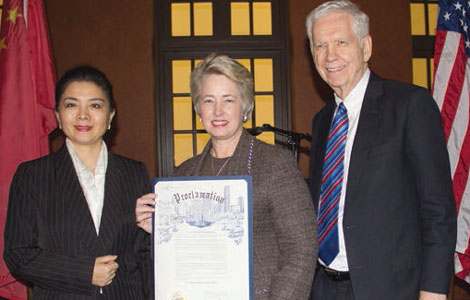
 Houston-China bonds deepen with new group
Houston-China bonds deepen with new group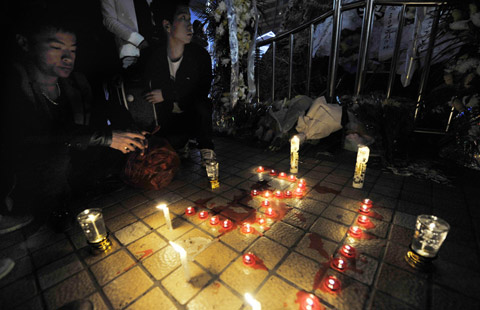
 Citizens mourn victims of Kunming terror attack
Citizens mourn victims of Kunming terror attack
 Putin justifies potential military move in Ukraine
Putin justifies potential military move in Ukraine
 Photos: Kunming rail station violence
Photos: Kunming rail station violence
 Successful businessman gives back to the community
Successful businessman gives back to the community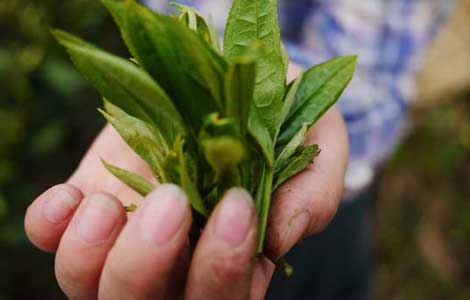
 Tea with heart
Tea with heart
 Wanting Qu: Chinese-Canadian singer-songwriter launches tour
Wanting Qu: Chinese-Canadian singer-songwriter launches tour
Most Viewed
Editor's Picks

|

|

|

|
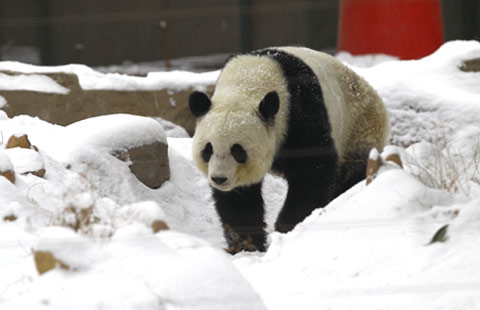
|
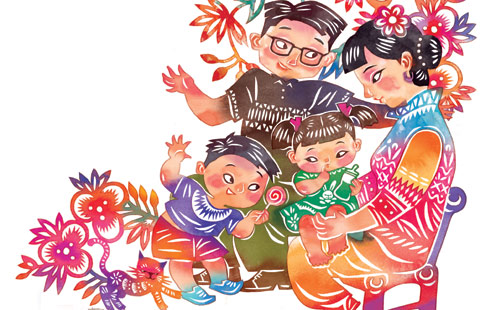
|
Today's Top News
China to severely punish terrorist attackers
Ukraine mobilizes after Putin's move
Travel the world via the Times Show
China: no one is above the law
China urges solution in Ukraine
Beijing vows tough stance on smog
28 dead in Kunming rail station violence
China rejects US GM corn shipments
US Weekly

|

|


